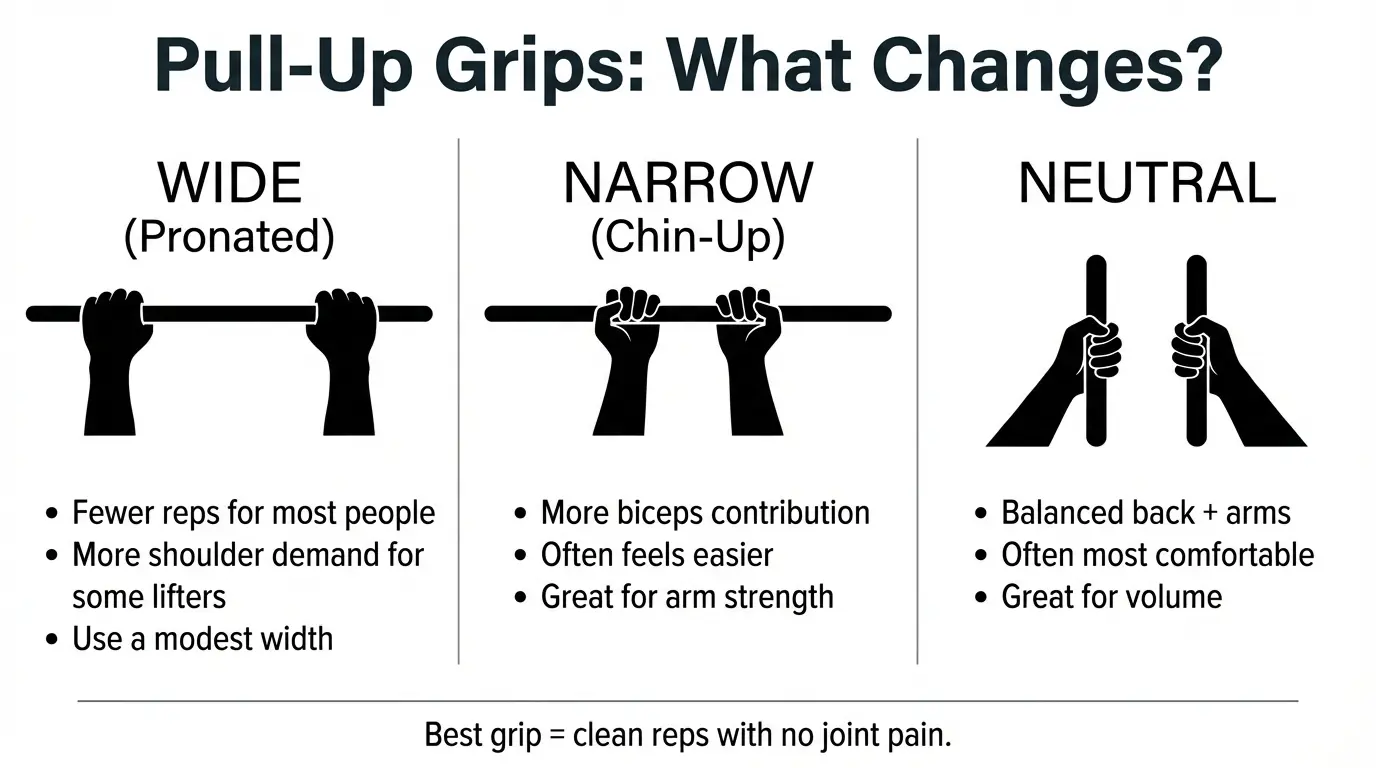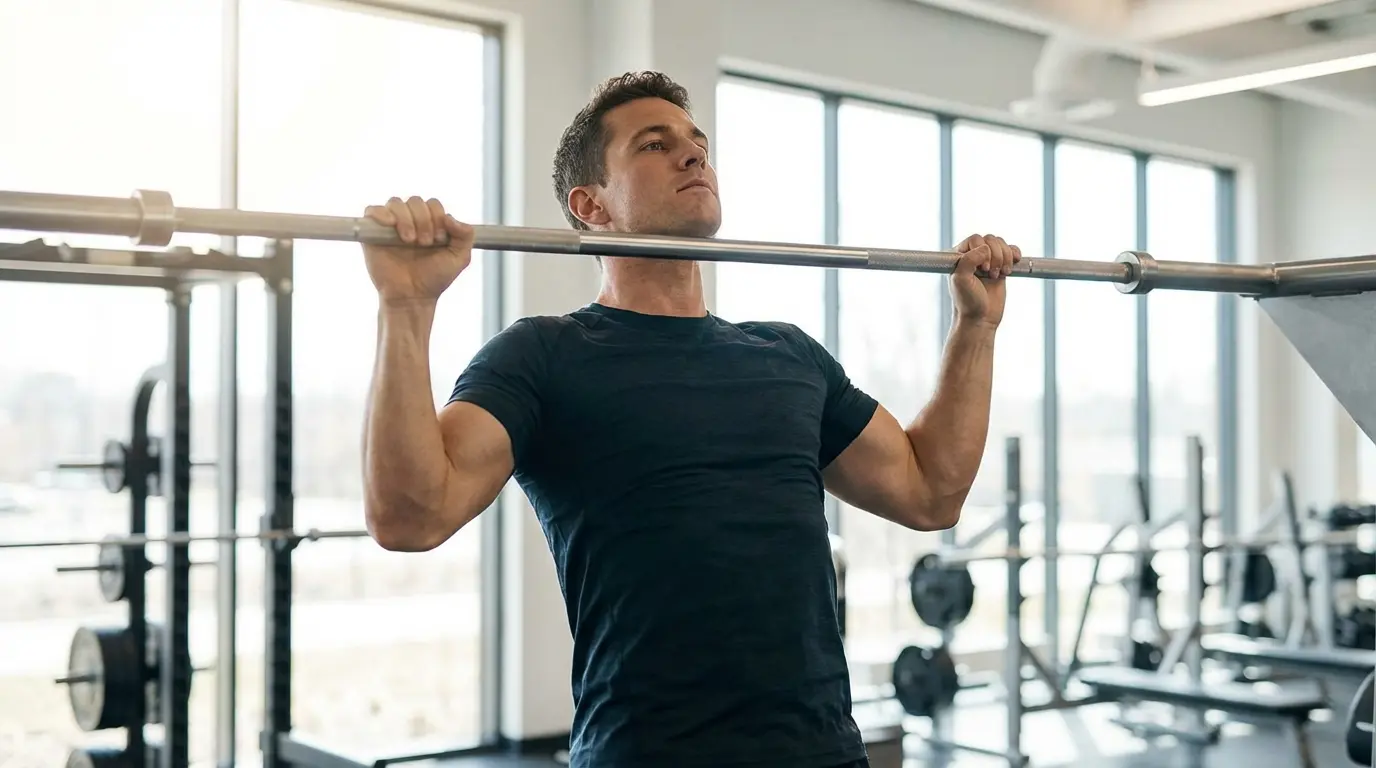Pull-ups are one of the simplest “big moves” you can do for back and arm development — but your grip changes the feel, the joints involved, and (to a smaller extent than most people expect) which muscles do the most work.
Here’s the truth that stops a lot of confusion: grip changes muscle emphasis at the margins, but form and effort drive the main result. Pick the grip that lets you train hard, pain-free, and consistently — then rotate grips to stay balanced.
Table of contents
- Quick answer: which grip should you use?
- What “muscle activation” actually means (and what it doesn’t)
- The pull-up muscles: a 10-second anatomy map
- Wide grip pull-ups: when (and when not) to use them
- Narrow grip: pronated close-grip vs chin-up
- Neutral grip pull-ups: the “joint-friendly” middle ground
- Comparison table: activation, difficulty, joint stress
- Form cues that increase lat involvement
- Programming: how to rotate grips for strength and size
- Beginner progression (from zero to your first pull-up)
- Troubleshooting pain: elbows, shoulders, wrists
- FAQ
- Summary
Quick answer: which grip should you use?
Use this decision tree:
- Want the most shoulder-friendly option? Start with neutral grip.
- Want more upper-back “tightness” and scapular control? Use pronated (overhand), shoulder-width.
- Want more arm/biceps contribution (often feels easier)? Use chin-up (supinated), usually narrower.
- Thinking about very wide grip? Use it sparingly — most people get the same benefits with a moderately wide grip and better range of motion.
What “muscle activation” actually means (and what it doesn’t)
When people talk about activation they’re usually referencing EMG studies (electromyography). EMG is useful, but it’s not a perfect scoreboard for muscle growth. A few practical rules:
- Small EMG differences don’t automatically mean big hypertrophy differences.
- Your rep quality (range of motion, control, effort near failure) often matters more than grip choice.
- Grip can still matter because it changes:
- how many clean reps you can do
- which joints get stressed
- where you feel the movement (mind–muscle connection)
So use “activation” as a guide, not a religion.
The pull-up muscles: a 10-second anatomy map
The pull-up is mainly:
- Shoulder adduction/extension (lats, teres major, some posterior deltoid)
- Scapular depression + retraction (lower trap, middle trap, rhomboids)
- Elbow flexion (biceps, brachialis, brachioradialis)
Your grip mostly changes the elbow flexor contribution and the scapular mechanics.
Wide grip pull-ups: when (and when not) to use them
A “wide grip” typically means hands well outside shoulder width, almost always with a pronated (overhand) grip.
What it tends to do
- Often reduces your range of motion (harder to get your chest up to the bar cleanly)
- Often reduces total reps you can perform
- Changes shoulder position, which can be less forgiving for some shoulders
The science / safety angle (important)
Biomechanics work comparing pull-up techniques has found that wide-grip pull-ups can show movement patterns associated with increased subacromial impingement risk, largely due to the shoulder and scapular positions involved at high elevation. That doesn’t mean “wide grip is dangerous for everyone,” but it’s a solid reason to keep wide grips modest and pain-free.
Best use cases
- You’re advanced, shoulders feel great, and you want variety
- You keep it moderately wide (not extreme) and maintain control
When to skip it
- You feel shoulder pinching at the top
- You can’t control scapular movement (you shrug up into your ears)
- You’re already dealing with cranky shoulders
Narrow grip: pronated close-grip vs chin-up
“Narrow” is a width — but in real gyms, “narrow pull-up” often becomes a chin-up (supinated, palms facing you). They’re not the same.
Option A: Narrow pronated (overhand)
This is a close-grip pull-up with palms away.
What it feels like
- Often feels more “arms + upper back” than a standard grip
- Can be tougher for many people than chin-ups
Why you’d use it
- You want a pull-up pattern that still emphasizes the back and scapular control
- You’re training for sports or skills that use a pronated pull
Option B: Chin-up (supinated, usually narrower)
This is the classic palms-toward-you chin-up.
What the research suggests
EMG research comparing pull-ups and chin-ups has found higher biceps brachii and pectoralis major activation in chin-ups, while pull-ups can show higher lower trapezius activity.
Why chin-ups often feel easier
Supination tends to put the biceps in a strong position to contribute. That can be great — unless you’re trying to learn to “use your lats” and you keep turning every rep into an arm exercise.
Neutral grip pull-ups: the “joint-friendly” middle ground
Neutral grip = palms facing each other (parallel handles).
Why many people love it
- Wrist position is more natural for a lot of lifters
- Often feels friendly on elbows and shoulders
- Tends to give a balanced “back + arms” feel
What research says (in plain English)
When researchers have compared pull-up variations using different hand orientations (pronated/supinated/neutral), the overall muscle activation across many upper-body muscles is often more similar than people expect — with some specific differences showing up (for example, one study reported higher middle trapezius activation in pronated vs neutral over full reps).
So neutral isn’t “magic activation.” It’s usually “I can train harder, longer, and pain-free,” which often wins in the real world.
Comparison table: activation, difficulty, joint stress
| Grip type | Typical setup | Tends to emphasize | Feels like | Joint stress (typical) |
|---|---|---|---|---|
| Wide (pronated) | Hands well outside shoulders | Upper-back feel / lat “stretch” (varies) | Harder, fewer reps | Higher for some shoulders |
| Standard (pronated) | Just outside shoulders | Back + scapular control | “True pull-up” | Moderate |
| Narrow pronated | Hands inside shoulders | Arms + upper back | Tough | Moderate |
| Chin-up (supinated) | Usually shoulder-width or narrower | Biceps + chest contribution | Often easier | Moderate (elbows can get cranky if overdone) |
| Neutral | Parallel handles | Balanced back + arms | Smooth / repeatable | Often lowest |
Form cues that increase lat involvement

If you’ve ever felt pull-ups mainly in your arms, fix these:
- Start with a “packed” shoulder
- Before you bend your elbows, pull your shoulder blades down and slightly back (think “put shoulders in back pockets”).
- Drive elbows down toward your ribs
- Don’t think “chin to bar.” Think “elbows to hips.”
- Stay tall through your chest
- Ribs down, but chest proud. Avoid turning it into a rounded “curl.”
- Control the eccentric
- Lower in 2–3 seconds. EMG work shows meaningful differences between concentric and eccentric phases — and controlled eccentrics are a major driver of strength and size.
Programming: how to rotate grips for strength and size
[image 4]
Here are three simple rotation plans depending on your goal:
Plan 1: Balanced strength + muscle (2x/week pull-ups)
- Day 1: Pronated (standard) — 4 sets
- Day 2: Neutral — 4 sets
Finish with 2 light sets of chin-ups (optional) if elbows feel good.
Plan 2: Back-dominant physique focus (3x/week pulling)
- Day 1: Pronated (standard) — heavier sets (3–6 reps)
- Day 2: Neutral — volume sets (6–10 reps)
- Day 3: Chin-ups — moderate reps (5–8) + biceps accessory
Plan 3: Elbow/shoulder-friendly volume build
- Day 1: Neutral — 5 sets
- Day 2: Neutral — 4 sets + slow eccentrics
- Day 3: Pronated (standard) — light technique work
Progression rule (simple):
- When you can hit the top of your rep range for all sets with clean form, add:
- 1 rep per set next week, or
- a small amount of weight (dip belt) and go back down in reps
Beginner progression (from zero to your first pull-up)
If you can’t do pull-ups yet, here’s the fastest path that doesn’t rely on luck:
- Dead hangs — 3 sets of 20–40 seconds
- Scapular pull-ups (tiny reps, straight arms) — 3x6–10
- Band-assisted pull-ups — 4x5–8
- Negatives (jump to top, 3–5 sec lower) — 4x3–5
- Full pull-ups — accumulate 10–20 total reps across sets
Most beginners do best learning on neutral grip or chin-up first, then building toward pronated pull-ups.
Troubleshooting pain: elbows, shoulders, wrists
Elbow pain (often tendon irritation)
- Switch to neutral grip
- Reduce volume for 1–2 weeks
- Slow eccentrics, keep reps submaximal
- Add forearm/extensor work (light)
Shoulder pinching at the top
- Avoid extreme wide grip
- Try neutral grip
- Focus on scapular depression (don’t shrug)
- Stop 1–2 cm short of the painful top position temporarily
Wrist discomfort
- Neutral grip is often easiest
- Keep wrists stacked (don’t “bend back” hard)
- Avoid death-gripping the bar unnecessarily
FAQ
Do wide grip pull-ups build wider lats?
Sometimes they feel that way, but the biggest driver of “wider back” is consistent pulling volume + progressive overload + good scapular control. If wide grip reduces ROM or irritates shoulders, it can backfire.
Are neutral grip pull-ups “best”?
They’re often the best default because they’re repeatable and joint-friendly for many people. But you still want some pronated work for balanced strength.
Should I train all grips?
Not every week — but rotating 2–3 grips over time is a smart way to build a stronger, more resilient upper body.
Summary
- Grip changes emphasis, but the biggest results come from effort, form, and progression.
- Neutral is often the most repeatable and joint-friendly.
- Pronated tends to be great for scapular control and “pure” pulling strength.
- Chin-ups add more biceps contribution and are often easier.
- Keep wide grips modest and pain-free, and prioritize clean ROM.
















